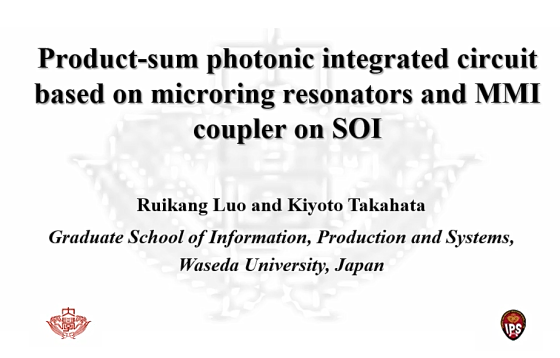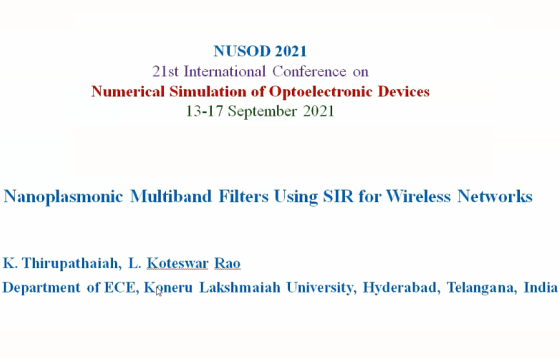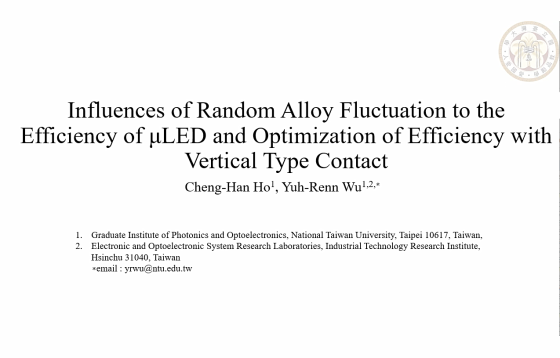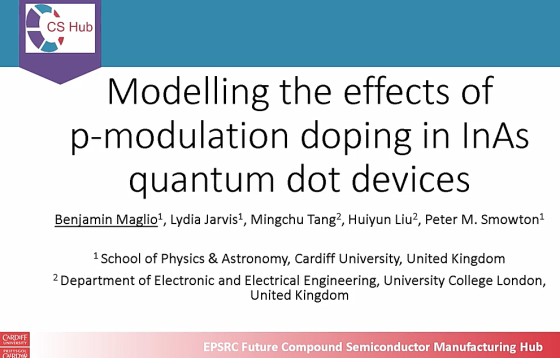


The absorption properties of HgCdTe based infrared detectors can be greatly increased in the mid-infrared band, by incorporating nanostructured plasmonic arrays on the illuminated detector face. The array periodicity, combined with the excitation of surface plasmon-polariton stationary modes, enhances the absorption efficiency by a substantial amount, allowing to reduce in turn the HgCdTe absorption thickness.
P07–Analysis of a phase shifter based on a slot polymeric waveguide with liquid crystal cladding
We numerically investigated a phase shifter based on a polymeric platform by using two different approaches. The device consists of a polymeric slot waveguide covered with an organic liquid crystal cladding, which is a promising configuration for the implementation of polymeric waveguide systems for computation, communication and sensing. Two different nematic liquid crystals have been […]
SC07–Impact of effective capture cross section on generation-recombination rate in InAs/GaAs quantum dot solar cell
Quantum dot solar cell structures have been theoretically analysed to study the impact of effective capture cross sections on quantum dot generation-recombination processes. The Poisson’s and continuity equation were solved self-consistently to obtain electrostatic potential, electron and hole carrier distribution, and electron filling of the QDs. The occupation probability of the QDs was used to […]
IS11–Design of all-optical Chalcogenide T-flip flop using Photonic Crystal Waveguide
The field of designing photonic crystal based all optical devices is the recent research trend as it remarkably promises an opportunity to diminish circuit complexity. The main intention of this present work is to contrive novel photonic crystal waveguide based all optical chalcogenide T-flip flop. Finally the efficient performance is numerically demonstrated to show elevated […]
N02–Wave-function engineering in (In,Ga)As/(In,Al)As core/shell nanowires
We study the electronic properties of In0.53Ga0.47As/InxAl1–xAs core/shell nanowires for light emission in the telecommunication range. In particular, we systematically investigate the influence of the In content x of the InxAl1–xAs shell and the diameter d of the In0.53Ga0.47As core on strain distribution, transition energies, and the character of the hole wave function. We show […]
LD08–Thermally-Enabled Transmission Line Laser Model with Arbitrary Sampled Gain Spectra
In this paper we demonstrate a directly coupled opto-electro-thermal (OET) transmission line laser model (TLLM) for edge emitting laser simulations and its comparison to physical simulations and measurements. Our results show that the OET TLLM has comparable computational efficiency to the standard opto-electronic (OE) TLLM and can include self-heating effects with good accuracy. As such […]
P12pd–Passive and active slab waveguide mode analysis using transfer matrix method
We present a general approach for numerical mode analysis of the multilayer slab waveguides using the Transfer Matrix Method (TMM) instead of the Finite Difference Frequency Domain (FDFD) method. TMM consists of working through the device one layer at a time and calculating an overall transfer matrix. Using the scattering matrix technique, we develop the […]
D04–Ge-on-Si waveguide photodetectors: multiphysics modeling and experimental validation
This work compares a multiphysics modeling approach with experimental measurements of two Ge-on-Si butt-coupled waveguide photodetectors. The coupled three dimensional electromagnetic and electrical simulation of the frequency response shows promising agreement with the measurements at 1310 nm, and provides detailed information about significant microscopic quantities, such as the spatial distribution of the optical generation rate.
P08–Design and Simulation of C-Shaped Optical Fiber Sensor
This paper presents a C-shaped optical fiber sensor for refractive index measurement. The design and simulation of the C-shaped optical fiber were conducted via Wave Optics Module-COMSOL Multiphysics®. The refractive index measurement ranging from 1.30-1.40 is performed. The simulation results showed that the C-shaped design has the potential to act as a refractive index sensor […]
MM01–Connecting atomistic and continuum models for (In,Ga)N quantum wells: From tight-binding energy landscapes to electronic structure and carrier transport
We present a multi-scale framework for calculating electronic and transport properties of nitride-based devices. Here, an atomistic tight-binding model is connected with continuum based electronic structure and transport models. In a first step, the electronic structure of (In,Ga)N quantum wells is analyzed and compared between atomistic and continuum-based approaches, showing that even though the two […]
LED02–Rigorous simulation of photon recycling effects in perovskite solar cells and LEDs
Secondary photogeneration due to reabsorption of internally emitted photons in metal halide perovskites is assessed using a novel dipole emission model that is compatible with detailed balance rates. The model considers the non-uniform local photon density of states of thin film absorbers/emitters consistently in internal and external emission and provides insight into the impact of […]
IS08–Product-sum photonic integrated circuit based on microring resonators and MMI coupler on SOI
A product-sum photonic integrated circuit consisting of SOI-based cascaded microring modulators and a 4×1 multimode interference coupler is proposed for CNN computing. A basic product-sum operation is numerically demonstrated for 2×2 matrix.
N03–Numerical and Experimental Characterization of Chirped Quantum Dot-based Semiconductor Optical Amplifiers
We present a model for the description of the dynamical behavior of Quantum Dot (QD) based Semiconductor Optical Amplifiers (SOAs) under injection of optical pulses. The model uses a Time Domain Traveling Wave (TDTW) approach to describe the optical field in the amplifier, and allows us to consider chirped QD materials by the inclusion of […]
LD09–Understanding the photon-photon resonance of DBR lasers using mode expansion method
Photon-photon resonance (PPR) in DBR lasers is studied by numerical simulations, which are based on the mode expansion and the rate equations. It is found that the photon number and the mode coupling factor play important roles to understand physical mechanism of the PPR behind.
P11pd–Numerical Simulations on Quantum Noise Squeezing for CW Light in Highly Nonlinear Tellurite Fibers
Quantum noise suppression of light is desirable for a lot of applications including quantum communication, quantum sensing, and detection of gravitational waves. There are several ways to obtain squeezed light including Kerr squeezing in optical fibers. Silica fibers are commonly used for this purpose. Here we propose to use highly nonlinear tellurite glass fibers for […]
D05–Evaluation of material profiles for III-V nanowire photodetectors
In this paper we report the simulation-based design of experiment (DoE) study for three different types of III-V based pin photodetectors operating at various wavelengths. Our DoE work shows that the optimal configuration for each device is strongly determined by the wavelength at which we are aiming to operate the photodetector and that a trade-off […]
P09–Nanoplasmonic Multiband Filters Using SIR for Wireless Networks
This article demonstrates design and numerical analysis of the multiband band-pass and band-stop filters using an even-mode MIM waveguide-based step impedance resonator (SIR) and simultaneously operated at optical bands O & L bands (185.72 THz and 230.02 THz) with higher efficiency (>35 dB)
IS01–Improved Phase Detection in On-Chip Refractometers
An improved phase detection scheme for Mach-Zehnder and bimodal interferometers is presented. By using a 90° hybrid, always two outputs operate at a highly sensitive point and the phase-shift-unambiguousness is extended to a range of 2π. The phase detection is independent of mode attenuations and input power fluctuations.
LED03–Influences of Random Alloy Fluctuation to the Efficiency of micro-LED and Optimization of Efficiency with Vertical Type Contact
µ-LED’s efficiency is enormously dependent on the chip size, which is believed to be the influence of sidewall traps. However, the decrease of IQE in AlInGaP based red LED is much stronger than nitride based LEDs. This paper examines the role of random alloy fluctuation with our 2D simulation software for the whole LED chip […]
MM02–Efficient multi-band k·p calculations of superlattice electronic and optical properties using plane waves
Solving the multi-band k·p Schrodinger equation for a quantum-confined heterostructure using a reciprocal space plane wave approach presents several advantages compared to conventional real space approaches such as the finite difference or element methods. In addition to allowing analytical derivation of the heterostructure Hamiltonian, a desired level of accuracy in the computed eigenstates can generally […]
N04–Bismuth-containing GaAs core-shell nanowires
This work theoretically investigates the electronic and optical properties of GaBixAs1–x/GaAs core–shell and GaAs/GaBixAs1–x/GaAs multi-core–shell nanowires. Our results show a large tuning of absorption wavelength (0.9 µ to 1.6 µ) by varying Bi composition and/or nanowire diameters. The computed polarisation dependent optical spectra indicate the possibility to incorporate such nanowires in photonic devices desiring isotropic […]
LD10–Optical Feedback Regimes Suitable for Distance Measurement with a Ring Laser
We numerically study the behavior of a ring laser subject to bidirectional delayed optical feedback, when the isolated laser is in the quasi-unidirectional regime. We find different regimes, two of which are of special interest, because the laser switching period, between the clockwise and the counter-clockwise mode, is linearly related to the time of flight […]
NM08pd–Brillouin Gain Coefficients of Magnetoactive Doped III-V Semiconductors: Hot Carrier Effects
Hot carrier effects (HCEs) of an intense pump wave on (steady-state and transient) Brillouin gain coefficients of magnetoactive doped III-V semiconductors are investigated. Numerical analysis is made for n-InSb crystal – CO2 laser system.
D06–Photoresponse uniformity in planar InP/InGaAs avalanche photodiodes
Numerical simulation of the electric field distribution and photocurrent response of a planar InP/InGaAs avalanche photodiode is presented as a function of varying multiplication width. The Zn dopant diffusion front is obtained by numerically simulating the diffusion process. The simulation results indicate that while a local peak value of the electric field is observed near […]
IS02–Numerical Simulation of Optical Through-Silicon Waveguide for 3D Photonic Interconnections
Optical interconnections are a promising step forward to overcome the intrinsic limitations of electrical interconnections in integrated circuits. In this work, we present a finite element method (FEM) simulation study of a dielectric waveguide etched through the full thickness of a silicon substrate. In particular, it is investigated the effect of the bridge-to-core size ratio […]
P01–Design of a computer-generated waveguide hologram for integrated free space sensing
In this work we present a design of a computer generated waveguide hologram coupler with an ultra-long working distance and wavelength multiplexing in the near infrared. An approximation method to compute the scalar field from a detour phase hologram is presented. The accuracy is comparable to FDTD but it is achieved much faster. Coupling efficiency […]
LED04–Marked efficiency enhancement of 222 nm AlGaN-based deep-UV LEDs for disinfection of SARS-2 (Covid-19)
The AlGaN-based deep ultraviolet light emitting diodes (DUV LEDs) for the disinfection of SARS-2 (Covid-19) are proposed in this study. The optoelectronic characteristics of DUV LEDs are numerically analyzed. The results show that the internal quantum efficiency (IQE) and radiative recombination rate are excellently improved in the proposed LED. This significant enhancement is due to […]
MM03–Parameter Estimation of an Ion-Exchange Process Based on a Pseudo Probability Measure
For the realization of integrated optical waveguide components, needed for integrated photonic circuits, a promising approach to manufacturing is their embedding in thin glass sheets by thermal diffusion processes. Because prototyping or manufacturing small batch series is costly, appropriate numerical simulations are used in order to allow an accurate characterization. However, in practical applications it […]
N05–Modeling the effects of p-modulation doping in InAs quantum dot devices
A modeling routine has been developed to quantify the effects of p-modulation doping in the waveguide core region of InAs quantum dot (QD) devices. Utilizing one dimensional approximations, simulated outputs of reverse and forward devices are simulated providing insight into absorption and gain properties.


































